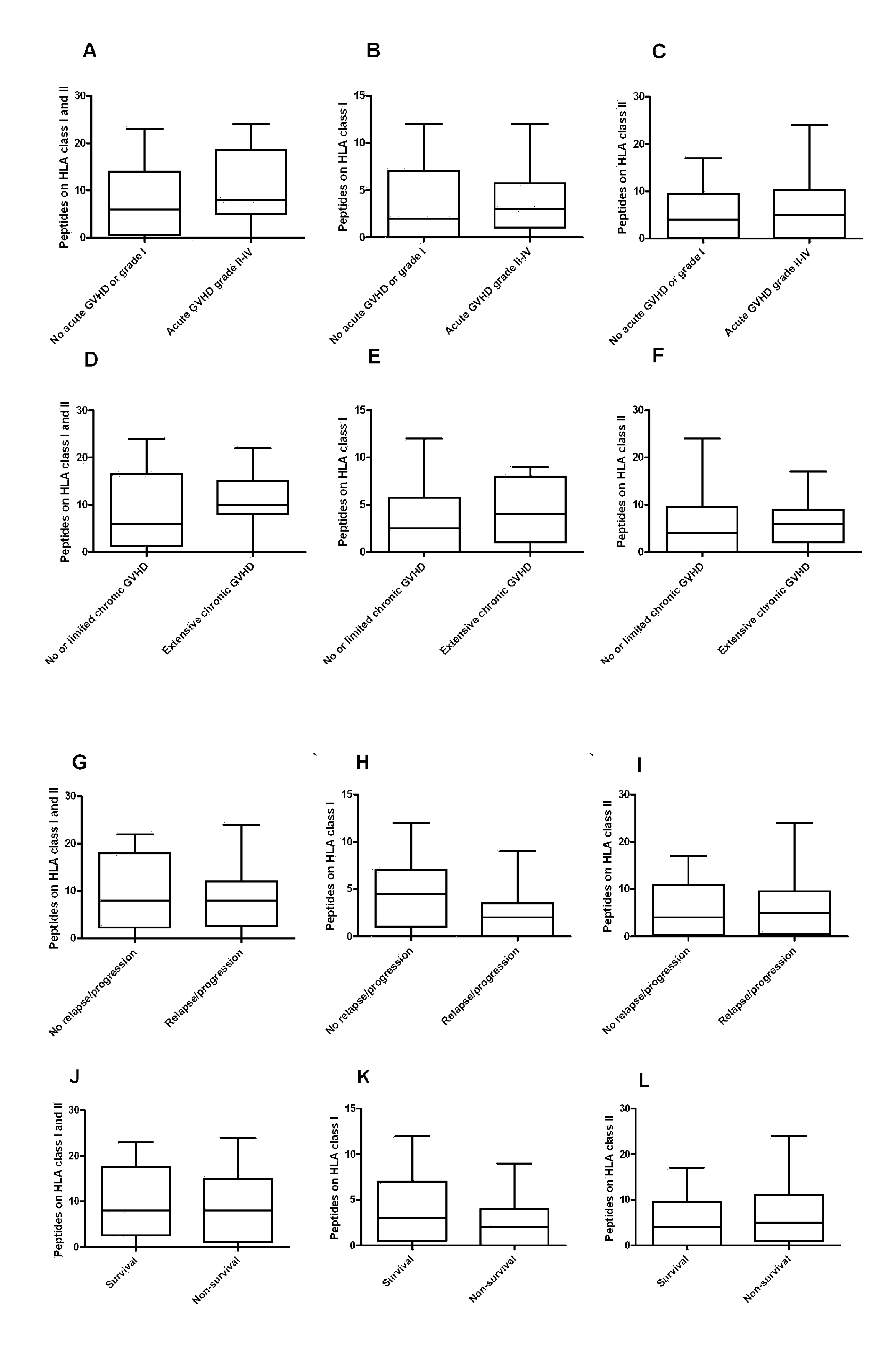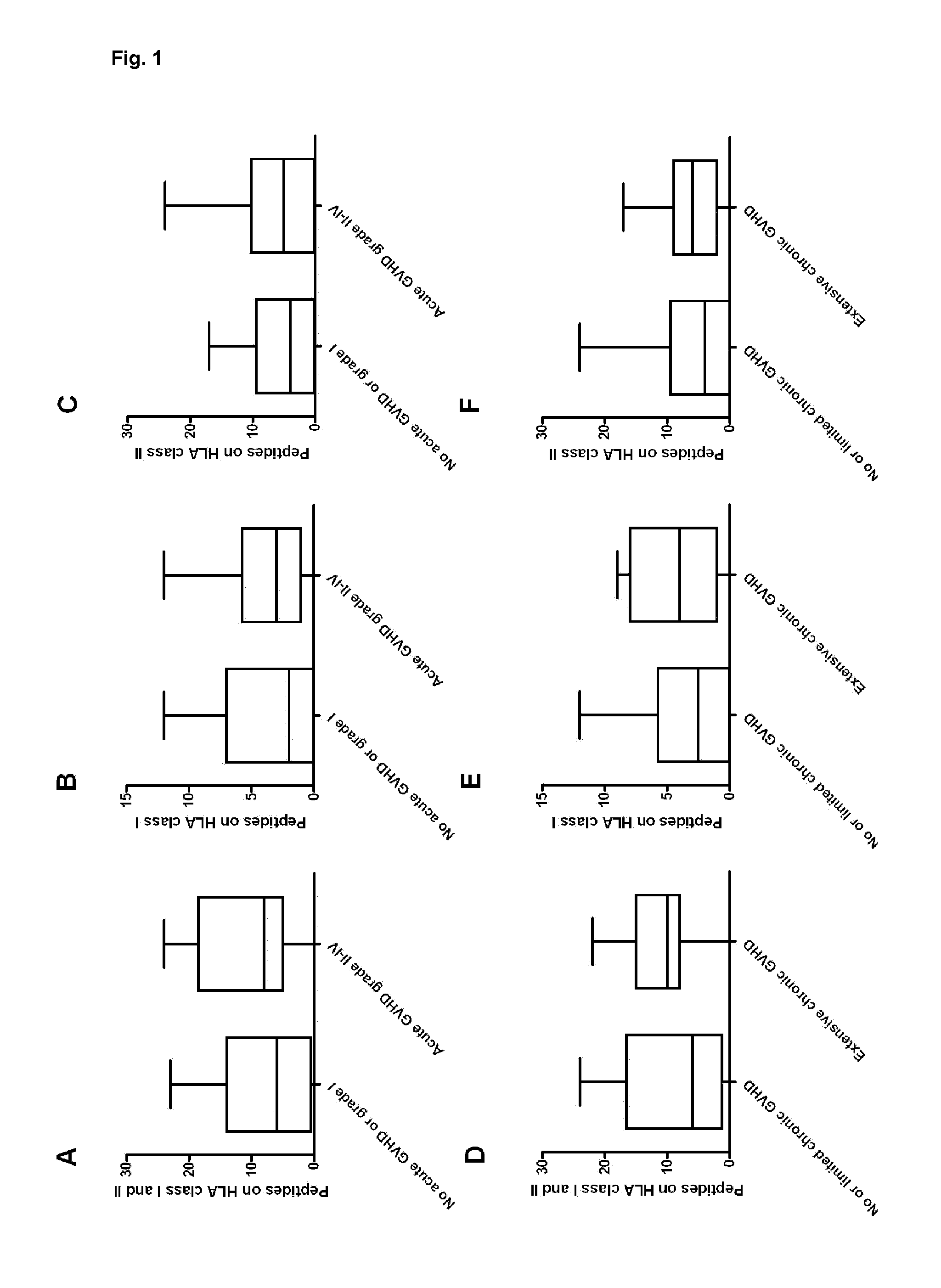Method for prediction of an immune response against mismatched human leukocyte antigens
- Summary
- Abstract
- Description
- Claims
- Application Information
AI Technical Summary
Benefits of technology
Problems solved by technology
Method used
Image
Examples
Example
Example 1
Risk of Alloreactivity after Mismatched-HSCT Increases with Increasing Numbers of Recipient-Specific HLA-Peptides Presented by Shared-HLA Molecules
Summary of Example 1:
[0133]Background: Graft-versus-host disease (GVHD) is one of the major limiting factors of hematopoietic stem-cell transplantation (HSCT). An established risk factor for GHVD is HSCT with an HLA-mismatched unrelated donor. Some mismatches appear to be more permissible, while others lead to an increased risk of developing GVHD. Currently, the biological basis for alloreactivity due to these non-permissible mismatches is unknown. The present example demonstrates use of a method to predict non-permissible mismatches and their association with the presentation of peptides derived from the recipient-specific mismatched-HLA molecules, by shared HLA to donor-T cells.
[0134]Methods: Retrospectively, 48 non-myeloablative conditioned patients, transplanted with a 9 / 10-matched unrelated donor, were analysed. HLA-typing w...
Example
Example 2
Predicted Indirectly ReCognizable HLA Epitopes Correlate with Chronic Graft-Versus-Host-Disease and Relapse-Related Mortality in Pediatric Patients after Cord Blood Transplantation
Background and Objectives:
[0160]Haematopoietic Stem-Cell Transplantation (HSCT) with an HLA-mismatched donor is a risk factor for Graft-Versus-Host Disease (GVHD). According to the present invention, graft-versus-host reactivity after HSCT with single HLA mismatched adult-unrelated donors can be predicted in advance. It is preferred that the number of peptides derived from the mismatched-HLA allele presented in matched HLA (Predicted Indirectly Recognized HLA Epitopes; PIRCHES) correlates to the development of alloreactivity. Since HLA mismatches are better tolerated in case of transplantation with Cord Blood (CB), CB donors are often selected with more than a single HLA mismatch. According to the present invention preferably the number of PIRCHES correlates to alloreactivity after CB transplantat...
Example
Example 3
Predicted Indirectly Recognizable HLA Epitopes Presented by HLA-DRB1 Correlate with the De Novo Development of Donor-Specific HLA IgG Antibodies after Kidney Transplantation
[0163]The present invention provides methods for prediction of the role of T-helper cell epitopes derived from HLA class-I molecules presented by HLA class-II molecules from the recipient in the formation of donor-specific HLA antibodies of the IgG isotype. A role for the HLA-DRB1 molecule of the recipient in the formation of these antibodies has been suggested earlier. In Example 3 a large cohort of more than 800 kidney recipients is used. From this cohort, all non-immunized patients receiving their first kidney transplant are selected, followed by rejection and nefrectomy. The de novo production of donor-specific HLA class-I antibodies (DSA) is analyzed and correlated data the predicted indirectly recognizable HLA epitopes presented by HLA class II of the recipient (designated as PIRCHE-IIs). Despite t...
PUM
| Property | Measurement | Unit |
|---|---|---|
| Molar density | aaaaa | aaaaa |
| Molar density | aaaaa | aaaaa |
| Length | aaaaa | aaaaa |
Abstract
Description
Claims
Application Information
 Login to view more
Login to view more - R&D Engineer
- R&D Manager
- IP Professional
- Industry Leading Data Capabilities
- Powerful AI technology
- Patent DNA Extraction
Browse by: Latest US Patents, China's latest patents, Technical Efficacy Thesaurus, Application Domain, Technology Topic.
© 2024 PatSnap. All rights reserved.Legal|Privacy policy|Modern Slavery Act Transparency Statement|Sitemap



